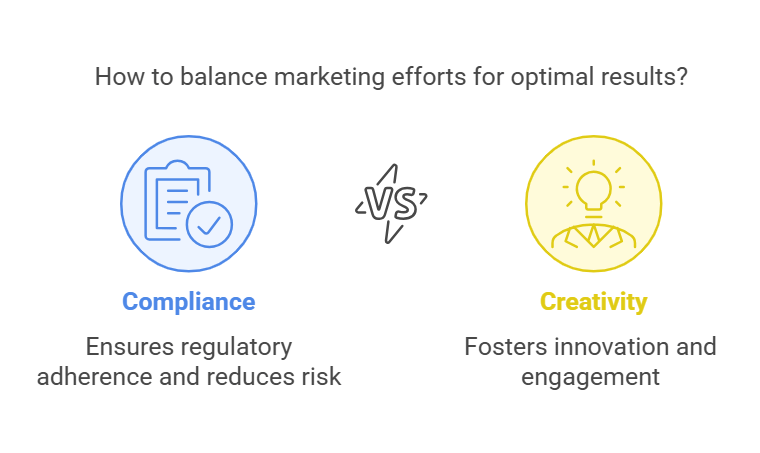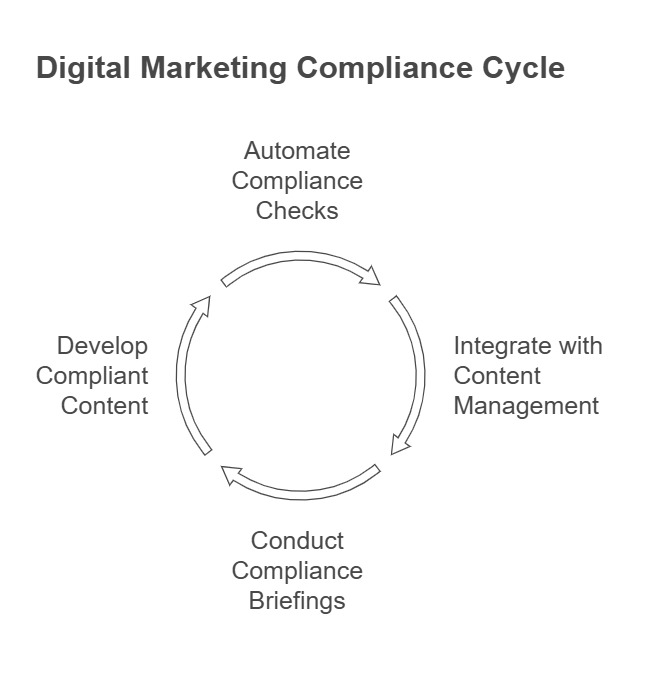Introduction
This article explores how to maintain your brand integrity, manage compliance requirements, and foster innovative campaigns by bridging the gap in marketing compliance between creative teams. Learn where the line is when it comes to marketing compliance so you can deliver impactful marketing campaigns in a manner that resonates with audiences and complies with all regulations.
According to a 2023 survey by the International Marketing Federation, over 89% of marketers in highly regulated industries struggle with balancing regulation and creative ideas. This challenge underscores the growing need for more precise guidelines on compliance requirements. Below, we unpack the nuances involved in ensuring compliance and marketing synergy without sacrificing innovation or audience engagement.
1. Why Compliance vs. Creative Marketing Matters

When it comes to marketing compliance, most organizations struggle with balancing legal requirements and creative aspiration. Marketing and advertising staff desire to awe audiences with fresh campaigns. However, legal and compliance boundaries always hover in the background. Ignoring these boundaries can result in significant fines or reputational losses.
1.1 Understanding Compliance Requirements and Potential Compliance Issues
• Compliance requirements differ based on your industry. In highly regulated industries such as healthcare and finance, regulations can be especially strict.
• Potential compliance issues surface if marketing messages overpromise or fail to accurately represent products or services.
• Inability to provide compliance normally brings about risks associated with compliance, ranging from lawsuits to sizeable monetary penalties that tarnish your brand’s reputation.
Action Steps
- Identify regulatory requirements specific to your region and industry. Studying relevant regulations and industry standards, such as HIPAA or GDPR, helps you craft effective marketing content.
- Perform a compliance review for every marketing initiative to detect potential compliance issues before they escalate. A comprehensive compliance review process can save time and money down the line.
- Collaborate with compliance teams by establishing open communication channels. This ensures creative teams get early-stage feedback on fresh ideas.
2. Challenges of Marketing Compliance in Highly Regulated Industries

Marketing compliance challenges become more acute when rules strictly regulate business conduct. Growth marketing strategies can conflict with stringent regulations on data use, claims, and disclosures. The scenario demands sensitive regulation and risk management without stifling the creative flame.
2.1 Discuss Challenges and Compliance Burden
• Compliance challenges, such as extended review and approval phases, can bog down marketing campaigns.
• The heavier the compliance responsibilities, the more significant the compliance burden placed on each marketing team member who might be striving to work at a faster pace.
• Without a streamlined approval process, even the most visionary campaigns can wilt under multiple review rounds.
Key Points
• Legal needs vary broadly, so marketing team members must have access to the information they require.
• Dedicated compliance briefings accelerate final approvals by consolidating important regulatory updates in one place.
Mini-Checklist
- Identify pain points within your compliance process. Determine common roadblocks and plan ahead to eliminate them.
- Set review timelines to keep marketing objectives on schedule.
- Implement marketing compliance program practices that track each piece of content from creation to publication.
3. Bridging the Gap Between Creativity and Compliance

The gap between compliance and creativity can stifle innovation if left unaddressed. Closing the gap assists organizations in creating marketing campaigns that are not only engaging but also compliant.
3.1 Marketing Compliance Between Creative Teams and Compliance Teams
• Marketing compliance between creative teams and compliance teams can be seamless if there is clarity from day one.
• Marketing agencies that proactively bridge the gap between creativity and regulatory mandates minimize last-minute revisions that derail schedules.
Workflow Tips
- Streamline the compliance approach. Leverage powerful software features to automate routine compliance checks at each milestone.
- Use controlled content reviews so only approved elements are finalized, maintaining consistency and ensuring compliant outputs.
3.2 How the Creative Process Can Stay Compliant
•Implement compliance early on in the creative process. This anticipates likely compliance issues prior to incurring heavy resources.
• Make sure compliance checks are done alongside ideation, not only when a campaign is ready to go live.
Expert Insight
• Legal and creative teams have a crucial part in designing innovative and regulatory marketing programs. With all stakeholders aligned, you are able to deliver compelling campaigns that engage the masses and are regulatory-compliant.
4. Developing a Compliant Marketing Strategy

Creating a compliance-based marketing strategy is vital for establishing credibility. If the company conducts business in very regulated sectors, compliance needs to be factored in from the beginning.
4.1 Key Components of a Compliant Marketing Strategy
- Risk Management: Identify and address compliance risks in the early planning stages to prevent expensive setbacks.
- Approval Process: Standardize a review and approval process for all marketing communications so nothing falls through the cracks.
- Monitoring and Feedback: Continuously optimize their compliance efforts with consistent feedback loops and performance metrics.
4.2 Ensuring Effective Marketing and Brand Integrity
• Maintaining brand integrity calls for consistent messaging across email marketing, social media marketing, and website copy.
• A successful marketing plan often pairs unwavering brand values with compliance best practices that address regulatory requirements.
Actionable Example
• Implement marketing audits every month to maintain compliance with new or revised regulations.
• Keep teams informed about the latest compliance updates through dedicated compliance briefings that outline any changes in local or international guidelines.
5. Managing Compliance Risks in Innovative Campaigns

It is difficult to match risk management with striking innovations. Regulatory compliance has to seep through all stages of your campaigns, from idea generation to publication.
5.1 Comprehensive Risk Management for Marketing Campaigns
• Marketing alignment and compliance guarantee bold creativity does not violate compliance standards.
• Always contemplate compliance issues while brainstorming new marketing initiatives or evaluating distribution channels.
Risk Checklist
- Identify compliance requirements for every component of your campaign, including images, text, and disclaimers.
- Set triggers that ensure that compliance guidelines are respected before content goes live.
- Track any potential compliance concerns in real time to pivot strategies if legal or regulatory feedback demands it.
6. Streamline the Compliance Workflow for Digital Marketing

Digital marketing has the potential for quick growth. However, unchecked growth without adequate controls tends to generate compliance issues that can snowball fast.
6.1 Automate Routine Compliance Checks with Powerful Software Features
• Automate routine compliance checks to validate your landing pages, blog posts, and social media marketing content. This reduces human error and speeds up publication cycles.
• Integrate your compliance review process within your content management platform to unify approvals and final launches.
6.2 Dedicated Compliance Briefings for Creative and Legal Teams
• Organize specific compliance briefings that enable creative and legal teams to have a central role in developing content from day one.
• Provide them with the information they require, including current regulations and guidelines, so that they can complete marketing materials that comply with applicable regulations and industry standards.
7. Measuring Success: Deliver Impactful Campaigns That Captivate Audiences
The ultimate objective is to deliver impactful campaigns that captivate audiences while adhering to compliance parameters.
7.1 Build Brand Awareness While Maintaining Integrity
• Regular review of compliance ensures consistent brand compliance.
• A measured approach to marketing objectives supports long-term brand awareness without sacrificing integrity.
7.2 Ethical and Effective Marketing Tactics
• Ethical practices foster trust, resulting in increased conversions and customer loyalty.
• Successful marketing is based on measurements that track both compliance with adherence and audience participation, giving an even picture of success.
8. Conclusion: Achieving Balance Between Marketing and Compliance
Marketing and compliance might appear to be conflicting forces, but they can complement each other to produce top-notch results. By meeting marketing compliance needs upfront, companies remain compliant without compromising creativity.
• Bridge the gap between creativity and compliance by involving compliance teams early in the creative process.
• Use workflow tools and approval process structures and automate routine compliance checks to preempt compliance issues.
• A coordinated marketing team can meet regulatory requirements and still produce the realization of truly dynamic campaigns that resonate with target audiences.
Extend an invitation to peers, clients, and industry stakeholders to share insights on how they integrate marketing and compliance in their own spheres.
